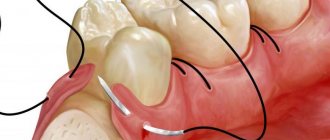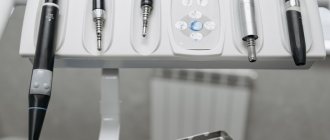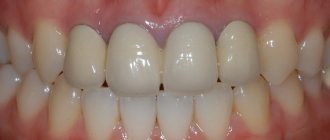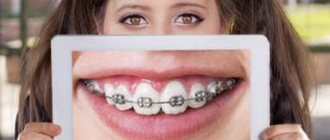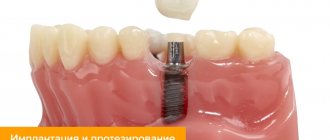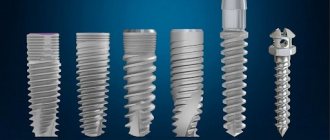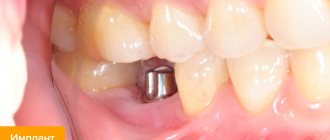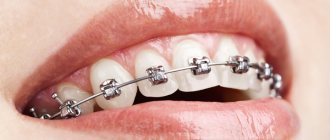Immersion of a dental implant into bone tissue is a surgical operation. During this procedure, the dentist cuts the soft tissue and removes the mucoperiosteal flap to gain access to the bone. After all installation procedures are completed, the gum is sutured to protect the implant installation area from infection. As a rule, sutures are removed after implantation no earlier than 7 days. Most often on the 10–14th day. These deadlines may vary in each individual case.
Types of materials for sutures in implantology
Dental practice uses several types of suture materials. All of them are classified into self-absorbable and non-absorbable.
Absorbable include
- Catgut;
- dexon;
- vicryl.
Catgut has been used for more than a century and is a classic. The threads dissolve in about two weeks due to the action of phagocytosis and enzymes. The disadvantage of the material is the ability to provoke tissue inflammation due to foreign proteins contained in its composition. The use of catgut during implantation is not recommended.
Dexon and vicryl are synthetic materials. The active substance of the first is polyglycomic acid, the second is polylactin. Resorption is promoted by hydrolysis. The period of complete dissolution takes about a month. Suppuration practically does not occur when using these threads.
Non-absorbable threads
- Silk;
- woven polyester;
- monofilament.
Silk , consisting of silkworm proteins, is often used by surgeons, but not for fixing bone grafts. It has one drawback - sometimes an inflammatory process develops in the area of the sutures. Braided polyester threads serve their purpose well, without complications.
Monofilament sutures with good mechanical properties are most suitable for implantology They do not cause reactions and are suitable for prolonged contact with the oral mucosa. The only negative aspect of the material is the rough ends. The problem is solved by fixing them with a special bandage.
How the choice of technology affects the implantation plan
Depending on the conditions, implant installation can take from 4 months to a year. Specific actions at each stage depend on the choice of technology, material, and physiology of the patient.
In modern dentistry, 4 types of dental implants are more often used, each of which has its own implantation plan.
- Intraosseous.
They are an artificial tooth root of various types (can be screw, blade-shaped, cylindrical). This technology for installing implants takes 5–6 months. The main stage - surgical - when using it is conditionally divided into 2 stages:
- Implantation of a pin. It is treated with a special compound - hydroxyopatite (a biocompatible inorganic mineral to prevent complications when implanting a titanium or ceramic “root” into the bone). After installing the pin, sutures are placed on the gum. The long period of implantation is explained by the need for complete healing of the gum tissue before the final step.
- Installation of the holder on which the crown part will be placed.
- Transosseous.
This is a complex technology for dental implantation, which limits its scope (only on the lower jaw). The essence of the procedure is the implantation of a metal bracket with pins of sufficient length into the lower jaw bone to pass through the bone. - Subperiosteal implants.
They are a durable metal frame with prepared holders for the crown part of an artificial tooth. They are implanted under the gum above the bone. This technology for installing a dental implant is used when there is insufficient bone tissue (and the impossibility of osteoplasty). - Mini implants.
Despite their small size (which determines the possibility of their use in narrow parts of the jaw), they are installed by analogy with intraosseous ones, going through the same stages.
Care instructions
Regular treatment of the operated mucosal area promotes successful healing. The procedure consists of several stages.
- Daily three-time antimicrobial rinses with Tantum Verde solution.
- To protect the tongue from damage by the hard ends of the threads, it is necessary to smear the operated area with Solcoseryl adhesive paste. It promotes rapid regeneration of the damaged area.
- Drug therapy includes taking Calcium d3 Nycomed, multivitamin complexes, painkillers (if the gums hurt). Anti-inflammatory drugs are prescribed to reduce swelling.
Additionally, the following rules must be observed:
- give up solid food, hot dishes, drinks, hot spices, coffee (increases blood pressure);
- do not use a hard toothbrush;
- avoid intense training and heavy lifting;
- do not visit the sauna, bathhouse;
- stop smoking: cigarette smoke negatively affects the mucous membranes and increases the risk of inflammation.
- The diet should include pureed soups, boiled porridges, and broths.
It is important to maintain oral hygiene to avoid the proliferation of pathogenic microorganisms. You need to brush your teeth carefully, without touching the operated area.
Installation of the crown part
The penultimate stage of implantation is prosthetics (building up the crown part of an artificial tooth). It is carried out 1–2 weeks after fixation of the abutment. May take different times depending on the type of crown chosen. Options:
- removable denture (budget option, justifies itself when replacing 4 or more teeth);
- fixed dentures (bridge or single);
- conditionally removable;
- combined options.
Regardless of the choice of prosthesis, its preparation is carried out in several stages. In the first step, the orthodontist makes an impression of the jaw. The procedure takes no more than 10 minutes and is performed without pain or discomfort. Necessary for making a crown of the correct shape and size in accordance with the structure of the jaw.
The second stage is the production of prostheses. The patient is not involved here. Crown elements are performed in the laboratory of the selected clinic within 2–4 weeks, depending on the choice of material (metal-ceramics, ceramics, precious metals).
At the third stage, a series of fittings and adjustments of the prosthesis to the patient’s bite is carried out. As soon as this process is completed, they are installed (using special locks if this is a removable model, or adhesive material if the dentures are permanent).
What to do if the suture breaks after implantation
There are times when the threads have weakened and come apart. This does not threaten the implant falling out, but there is a risk of infection . The situation must be corrected urgently.
After the examination, the doctor will take the necessary antiseptic measures and prescribe rinses. The recovery period after long complex operations is sometimes accompanied by antibiotic therapy. The rehabilitation course for each patient is compiled individually. If the tissues have not yet fused, the specialist will have to remove the stitches and then apply new ones.
How to reduce pain during recovery?
- Take a pain reliever before the anesthesia wears off.
- Follow the schedule of taking anti-inflammatory and antimicrobial medications prescribed by your implantologist.
- From the second day, rinse your mouth with saline and soda solutions, and antiseptic pharmaceuticals.
- Strictly follow the diet prescribed by your doctor.
- Apply ice to your cheek for the first few days after surgery.
- Avoid physical activity, get plenty of rest, and take proper care of your oral cavity.
You will find more recommendations in our article: “How to care for a dental implant.”
When do you need to see a doctor urgently?
If you notice one or more of the symptoms described above, contact your dentist immediately.
- Constant, incessant bleeding;
- High temperature after 3 days.
- Throbbing pain that is not relieved by painkillers.
- Severe swelling.
- Any pain that occurs 10 days after surgery;
- Sharp pain during and after osseointegration of the pin.
Important: Complications often arise due to errors during implant installation. To avoid this, choose an implantologist wisely and have your dental implants performed in a dental clinic with a reputation that provides a lifetime guarantee on treatment.
Suture removal after implantation
Patients are always interested in the question “On what day after implantation are the sutures removed?” Usually, for those whose healing went well and there was no suppuration, the threads are removed after 10-14 days. All this time, the area above the implant must be treated with antiseptics and protected from injury. The first days after surgery, you may feel as if threads are being pulled. Often there is a discharge of ichor. After the thread extraction procedure, which is absolutely painless, the doctor will recommend continuing the preventive course.
Possible complications
The risk of complications after implantation remains, especially if you choose an inexperienced doctor and violate general recommendations. Patients who have autoimmune diseases, weak immunity, and chronic diseases require special attention.
The most common complications of implantation are:
- implant rejection, development of peri-implantitis;
- damage to blood vessels and nerves of the face;
- bone atrophy;
- the appearance of bone growths;
- bleeding;
- seam divergence;
- pronounced swelling of the gums.
Natural reactions of the body to tissue damage during implantation such as swelling and moderate pain are not considered complications. To prevent swelling from increasing on the first day after surgery, it is necessary to apply dry ice to the cheek for 10 minutes, taking a break every 20-30 minutes. If your health worsens, it is worth visiting a dentist.
Some patients experience an increase in body temperature after implantation. For mild hyperthermia, there is no need to worry. If severe fever occurs, especially against the background of swelling and hyperemia of the gums, you should seek help from professionals. In this way, dangerous infectious complications can occur.
What to do next
The implantation process is quite long. After the threads are removed, the mucous membrane continues to grow over the implant. It shouldn't be visible. This takes approximately two months. Then prosthetics are performed. Installed orthopedic structures require careful care. The patient needs to master the technique of daily procedures that will help maintain a beautiful, healthy smile for a long time. These include:
- using a brush with soft bristles;
- brushing teeth twice a day;
- flossing;
- cleaning the areas where the implants come into contact with the gums using an irrigator;
- If plaque has formed, visit the dental office to remove it.
Patients who have undergone implantation should periodically visit specialists. This will help extend the service life of structures and avoid complications.
Installation of the healing abutment
A gum abutment is a temporary structure that is placed to create a natural contour around artificial teeth. It is a titanium cylinder that is screwed into a pin and worn for at least 2 weeks. Installation of the former is performed under local anesthesia, takes up to half an hour (incision - fixation - suturing) and also requires rehabilitation (from 4 days).
Prices in our Center are natural and final
The cost of the surgical stage of installing the Nobel implant is from 60,000 rubles. Includes the cost of the implant, its installation, anesthesia, bone reconstruction, installation of formers, as well as pre- and post-operative examinations.
Levin Dmitry Valerievich
Chief physician, Ph.D.
Contact experienced doctors
The level of qualification of a specialist is indicated by:
- practical experience working with implants;
- portfolio of work and client reviews;
- evidence of regular completion of advanced training courses;
- reputation and popularity of the clinic.
Our Center employs highly qualified doctors and employees of Moscow universities. They undergo internships in the USA and Germany and regularly take advanced training courses. Our implantologists know the nuances of all time-tested implantation protocols and the latest innovations. We will try to help and not disappoint you.
